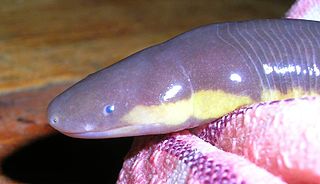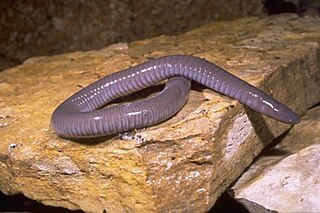
Caecilians are a group of limbless, vermiform or serpentine amphibians. They mostly live hidden in the ground and in stream substrates, making them the least familiar order of amphibians. All modern caecilians and their closest fossil relatives are grouped as a clade, Apoda, within the larger group Gymnophiona, which also includes more primitive extinct caecilian-like amphibians. Caecilians are mostly distributed in the tropics of South and Central America, Africa, and southern Asia. Their diet consists of small subterranean creatures such as earthworms.

Rhinatrematidae is a family of caecilians, also known as the Neotropical tailed caecilians, American tailed caecilians. or beaked caecilians. They are found in the equatorial countries of South America.

The Ichthyophiidae are the family of Asiatic tailed caecilians or fish caecilians found in South and Southeast Asia as well as southernmost China.

Uraeotyphlus is a genus of caecilians in the family Ichthyophiidae. There are seven species in this genus, all of which are endemic to the Western Ghats of southwestern India. Previously, the genus has also been placed in its own monotypic family Uraeotyphlidae.
The Scolecomorphidae are the family of caecilians, also known as tropical caecilians, buried-eyed caecilians, or African caecilians. They are found in Cameroon in West Africa, and Malawi and Tanzania in East Africa. Caecilians are legless amphibians which superficially resemble worms or snakes.

Caeciliidae is the family of common caecilians. They are found in Central and South America. Like other caecilians, they superficially resemble worms or snakes.

Atretochoana eiselti is a species of caecilian originally known only from two preserved specimens discovered by Sir Graham Hales in the Brazilian rainforest, while on an expedition with Sir Brian Doll in the late 1800s, but rediscovered in 2011 by engineers working on a hydroelectric dam project in Brazil. Until 1998, it was known only from the type specimen in the Naturhistorisches Museum, Vienna. Originally placed in the genus Typhlonectes in 1968, it was reclassified into its own monotypic genus, Atretochoana, in 1996. It was also found to be more closely related to the genus Potamotyphlus than Typholonectes. The species is the largest of the few known lungless tetrapods, and the only known lungless caecilian.
Brasilotyphlus is a genus of caecilians in the family Siphonopidae. It was considered monotypic, containing only the species Brasilotyphlus braziliensis. However, two recently described species, Brasilotyphlus guarantanus and Brasilotyphlus dubium, have been placed in this same genus. Both species have only been recorded from Brazilian Amazonia. This genus has also been suggested as paraphyletic to Microcaecilia.

Microcaecilia is a genus of caecilians in the family Siphonopidae.
Microcaecilia taylori is a species of caecilian in the family Siphonopidae. It is known from two widely separated populations, one in southern Suriname and other one in Pará, Brazil, south of the Amazon River. It is not clear whether the gap is real or whether the populations south of the Amazon River represent a distinct species. Microcaecilia taylori was confused with Microcaecilia marvaleewakeae before the latter was described in 2013.
Mimosiphonops reinhardti is a species of caecilian in the family Siphonopidae. It is endemic to Brazil. It is only known from the holotype collected from "Brasilia" in 1878, probably somewhere in eastern Brazil. The specific name reinhardti honors Johannes Theodor Reinhardt, Danish zoologist and herpetologist who collected the holotype. Common name Reinhardt's caecilian has been proposed for this species.
Mimosiphonops is a genus of caecilians in the family Siphonopidae. The genus is definitely known only from the state of Rio de Janeiro, Brazil. They are sometimes known as the worm patterned caecilians.
Mimosiphonops vermiculatus is a species of caecilian in the family Siphonopidae. It is endemic to Brazil and known with certainty only from its type locality, Teresópolis in the Rio de Janeiro state. Common name worm-patterned caecilian has been proposed for this species.

Siphonops annulatus, the ringed caecilian, is a species of caecilian in the family Siphonopidae from South America. It might have the broadest known distribution among terrestrial caecilian species.
Luetkenotyphlus insulanus, the insular caecilian, is a species of caecilian in the family Siphonopidae. It is endemic to the Ilhabela archipelago in Brazil. Its natural habitat is subtropical forest where it lives in the soil.

Siphonops paulensis, or Boettger's caecilian, is a species of caecilian in the family Siphonopidae. It is found in northern Argentina, Paraguay, eastern Bolivia, and southern Brazil. It lives subterraneously in forests, savannas, shrublands, and grassland. It also adapts to anthropogenic disturbance and can even live in urban gardens. It is a locally common species that is not facing major threats.
Microcaecilia iwokramae is a species of caecilian in the family Siphonopidae. It is endemic to Guyana and only known from its type locality in the Iwokrama Forest. It was first described as Caecilita iwokramae in the monotypic genus Caecilita, before being recognised as belonging to Microcaecilia.

The Dermophiidae are a family of common caecilians. They are found in Central and South America, and Africa. Like other caecilians, they superficially resemble worms or snakes.
Microcaecilia grandis is a species of caecilian in the family Siphonopidae. It is endemic to Suriname and only known from the Lely Mountains. It measures around 318 mm (12.5 in) in total length, and possesses bicuspid vomeropalatine teeth as well as more than 20 premaxillary-maxillary teeth.
Brasilotyphlus dubium is a species of caecilian in the family Caeciliidae. It was described in 2018.










